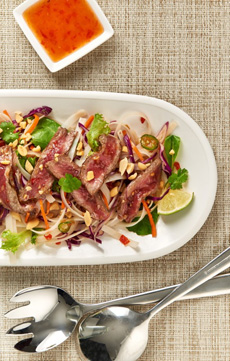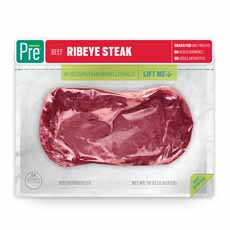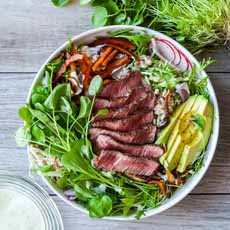TOP PICK OF THE WEEK: Grass-Fed Beef From Pre Brand
 [1] Check out the marbling on this grass-fed beef (all photos courtesy PRE).
|
We don’t eat a lot of beef because we don’t like cleaning up after it. But when we befriended new neighbors, serious carnivores, we received ongoing dinner invitations and began to eat much more of it. They cook only grass-fed beef. Grass-fed cattle are those whose diet after weaning consists only of fresh of stored grasses. Before modern mass production led to grain-fed diets, cattle ate only grass and silage (compacted grass, stored in a silo for the winter months). While you’d think the lower fat levels would mean less flavor, the steaks and ground beef we’ve had were, simply, luscious—juicy and tender. With grain fed beef, the flavor comes predominantly from fat. Grass fed beef has a more nuanced flavor and leaner taste (in a good way). Here are the reasons people prefer grass-fed beef: Compared to USDA Choice beef, grass-fed has: Our neighbors get their beef delivered from Pre, a Chicago-based company that sells 100% grass-fed steaks and ground beef under the Pre label. The Pre team is dedicated to selling the kind of beef that they want to eat. They use 15 quality checkpoints to ensure the flavor, tenderness and juiciness they want, along with a well-balanced marbling. The 15 points quality including breed, class, marbling, tenderness, size, weight, and of course, no added hormones, no added antibiotics and no feelots. Pre beef represents the top 10% in grass-fed beef. We attest: We were impressed. The line includes ground beef with different levels of leanness: 80%, 85%, 92% and 95%. Plus: Currently, Pre is sourced from select regions in Australia and New Zealand that offer ideal environmental conditions (rainfall & variety of grasses) for year-round pasture raising. These countries also have some of the highest animal welfare standards in the world. The animals never given antibiotics or growth hormones. Why not the U.S.? According to the company, the climate in the U.S. is not ideal for the high-quality, grass fed beef raised on pasture year-round. Note that imported beef does not receive USDA grading: Only cattle raised in the U.S. can be USDA graded. When you buy the packaged beef, you can tell it’s grass-fed at a glance: The raw beef actually has a purple-red color, from more myoglobin, a protein found in animal muscles. Once the package is opened and the beef is exposed to air, the color will change to a brighter red. |
|
|
DETAILS ABOUT GRASS-FED BEEF PRE beef cattle are fed fresh grass year-round. This is not true about all beef that is labeled grass fed. If you like drilling down to the details, here they are: What Is Pasture-Raised Beef? Another term heard in accordance with “grass fed” is “pasture raised.” This latter term has more to do with environment than diet. Cattle are not confined and are free to graze on open pasture. At a minimum, pasture raised animals must have continuous access to the outdoors for 120 days per year. At Pre, cattle are raised outdoors on pasture for their lifespan. Order online at EatPre.com. There are also gift cards. To our friends and family who are reading this: put us on the gift list! ________________ *CLA, conjugated linoleic acid, is a naturally occurring fatty acid found in meat and dairy products. It may help reduce body fat deposits and improve immune function. Our beef has up to 3 times the amount of CLA as USDA choice beef of the same cut.Here are the health benefits of CLA.
|
||





